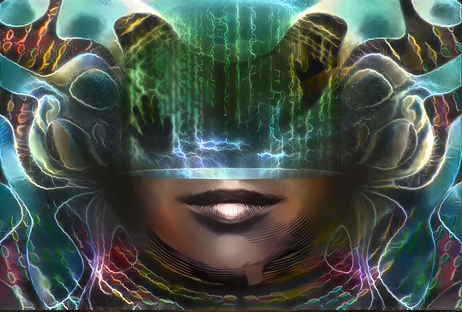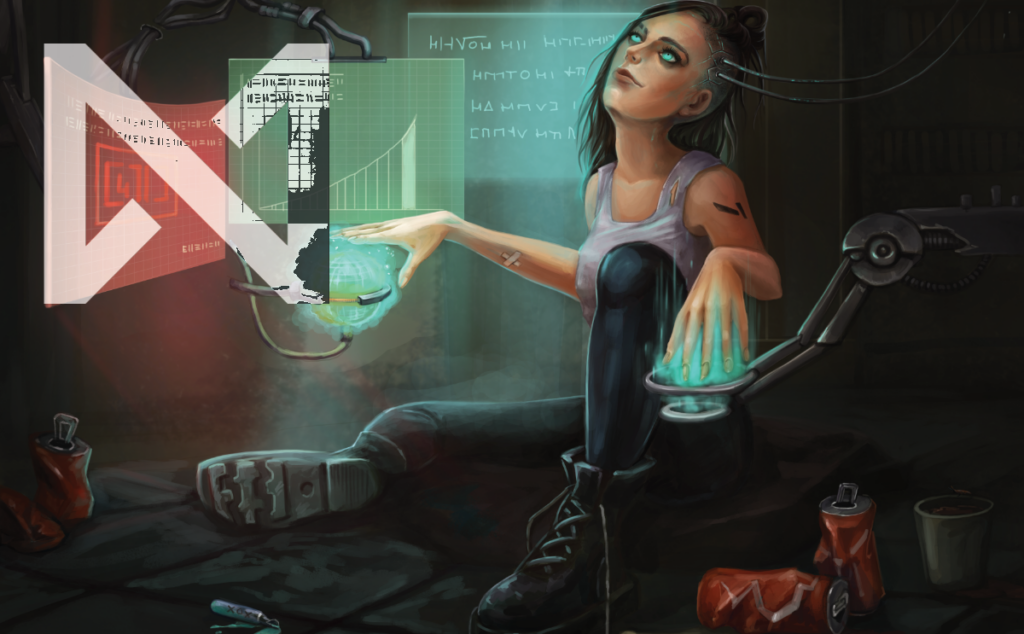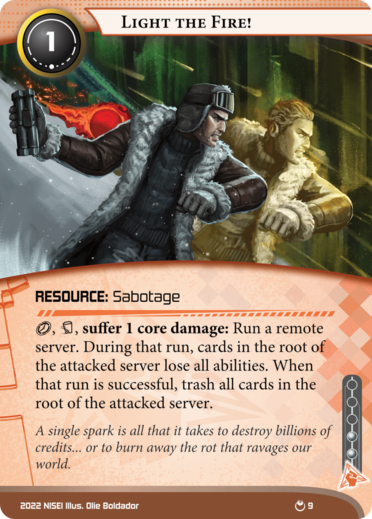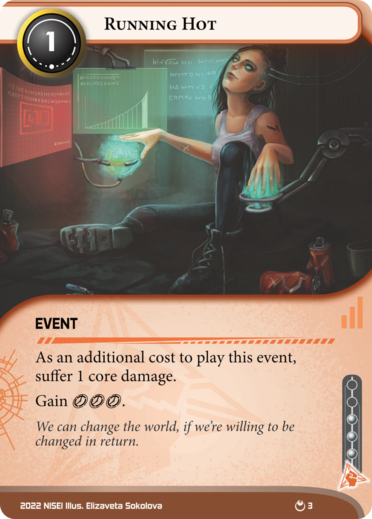Hello, fellow Netrunners! Laury here, from NISEI’s Equality, Diversity, and Inclusion (EDI) team. We work to ensure that NISEI and Netrunner represent a diverse range of people and maintain a safe and welcoming culture for everybody. Previews for our next set, Midnight Sun, begin tomorrow, and on the eve of preview season, we want to share with you an upcoming change to game terminology.
Beginning in Midnight Sun, the term “brain damage” will be replaced with “core damage” in this and all future NISEI products.
We recognize this is a significant change, and it’s not one that we made lightly. Let’s talk about why we’re retiring “brain damage” and what this does—and doesn’t—mean for Netrunner.
History
Netrunner has used the term “brain damage” since its very beginning. Cards from the original 1996 Netrunner game such as Code Corpse and Lucidrine™ Booster Drug used this term to describe an effect that has lasting consequences. Even today, experienced Runners may be able to shake off the net-damage sting of a Sting! or the meatspace pain of a Punitive Counterstrike, but brain damage, by permanently reducing the Runner’s maximum hand size, leaves a mark.
Every time the Runner takes a point of brain damage, not only do they suffer the immediate pain of discarding a card, but their maximum hand size is also reduced by 1 for the rest of the game. A smaller hand size means fewer options and less ability to hold onto their plans between turns. And as their hand shrinks, the Runner becomes more vulnerable to a flatline from other damage-inflicting effects!
Brain damage has historically represented a high risk to the Runner, so it’s no wonder that it found a particular home among Anarchs, the faction most eager to turn risk into reward. The theme carries weight and conveys the severity of the danger.
Unfortunately, it’s not all stims and roses.

Issues and Concerns
In a game of Netrunner, “taking brain damage” is as simple as discarding a card and taking a little token to remind you of your reduced hand size. Away from the table, though, “brain damage” means something more real.
In the modern medical lexicon in much of the world, the term “brain damage” has generally been phased out. Instead, the term “brain injury” is the preferred term to describe damage to the human brain. When “brain damage” is used, it is sometimes a denigrating colloquialism used to jeer at someone’s diminished capacity.
Language is a fluid thing, of course; we don’t believe that any of the previous stewards of Netrunner had this implication in mind when they used the term in the game. Nor do we believe that anyone in the wonderful Netrunner community is willingly, maliciously causing harm when they declare the results of their Hákarl 1.0‘s subroutines. But language has evolved since the 1990s, and in 2022, “brain damage” feels like a crude reference to a specific, potentially disabling injury. And it’s baked into the current vocabulary of our game.
We began considering this after community members who either live with brain injury or have loved ones who do brought us their concerns. As we analyzed the issue further, we noted that “brain damage” is an unusually specific form of damage. No other mechanic in Netrunner refers so specifically to an actual medical condition. Azef Protocol does not instruct the Corp to “break 2 tibia”. Rezzing an Anemone does not “inflict 2 aphasia”. Brain damage is the only place in a game of Netrunner where the rules of the game reference a real-world medical condition and disability, and they do so via one predictable, consistent limitation.
This was an especially relevant issue for us as we approached the release of the Borealis Cycle. As the Anarch identity you see tomorrow will suggest, the Anarch faction’s mechanical theme in Midnight Sun and Parhelion involves trading off permanent, lasting damage for powerful effects. And Anarch isn’t the only faction to dabble in this; as previews continue, you’ll see that laced throughout the cycle are cards that deal or interact with this type of damage. It was important to us to consider how the concentration of this mechanic would feel, not only for Netrunner players who have never experienced this kind of injury, but also those who have and live with its effects every day.
“What’s it going to feel like… listening to players happily receiving your disability? …Doing post-game analysis of whether taking a lot of your disability hurt their chances of winning?”
Netrunner Community Member
As one community member wrote, “What’s it going to feel like, sitting there playing a card game, listening to players all around happily receiving your disability (described in somewhat derogatory terms)? Talking through their turns in excited loud voices, or arguing about the rules around how much of your disability they have? Doing post-game analysis of whether taking a lot of your disability hurt their chances of winning?” Representing a disability as a game mechanic minimizes this disability by reducing it to a single event and single outcome, and presents it without thought towards people who are themselves affected by brain injury.
On top of that, this level of specificity can, at times, actually work as a creative stumbling block. Meat damage is broad: it’s any injury done to the Runner’s corporeal body. Net damage is similarly expansive, covering all forms of neural feedback done while jacked in. Only brain damage is thematically locked: it represents a critical injury to one specific organ. If the only tool in our toolbox for portraying permanent damage is by referring to a specific injury in a specific organ, we’re limiting the stories we can tell. Why should permanent, critical damage only happen to your brain?
The reality is that brain injury is much more complex than our game currently treats it. It results in such a wide range of outcomes, treatments, and coping strategies for different people that representing it as a single disability does not do justice to those who live with it. In Netrunner, “brain damage” is disabling in one rigidly specific way, not an injury and experience that occurs along a spectrum.
It is possible for board games to do this subject justice. The game Heading Forward by John DuBois is specifically about the complexities of recovering after a traumatic brain injury. The game is dedicated to navigating the complications such an injury could present. In that game, dealing with brain injury is not represented as a single statistic with a single mechanical implication, but a web of interacting systems, including money, cognitive space, and emotional energy. In Netrunner, however, we don’t have the space or focus to treat the subject with the care it deserves.
When we weighed the potential costs of continuing to use the term “brain damage” against its thematic and historical benefits, especially as we prepare to release a cycle that deals heavily with this mechanic, we concluded we can do better.
So we will.

Core Solution
Beginning with Midnight Sun, NISEI cards will no longer use the term “brain damage”. Instead, the same mechanic will be referred to as core damage.
This rename changes nothing about how this type of damage functions. Whenever the Runner suffers a point of core damage, they discard a card and their maximum hand size is permanently reduced by 1.
We will be implementing support for this change in the following ways:
- Future Card Text Updates releases will include changes to the official text of older cards so they refer to “core damage” instead of “brain damage”.
- In the interim, until this is addressed in a Card Text Update, the next version of the NISEI Comprehensive Rules will make clear that the two terms are completely interchangeable. Brain damage and core damage are not tracked separately from one another: they are two names for the same thing.
- A rules reminder card in Midnight Sun will explain core damage.
- New versions of the Learn-to-Play guide will refer to “core damage” instead of “brain damage” and will likely include a note in an appendix about the older terminology.
- We will add a note to our Frequently Asked Questions and Major Changes pages about the change in terminology.
- We will contact token makers in the community to offer suggestions for alternative iconography.
- We are still discussing internally how to address the “brain damage tracker” card included in System Update 2021.
Addendum: Since publishing this article, we have heard from a number of people wondering whether their existing tokens, which often depict a stylized brain, will still be permitted at NISEI events in light of this change. We apologize for not clarifying this when this article was first published, and append a statement on the matter from our Organized Play Manager:
You will not be banned for using old brain tokens, and there are no plans to ban these at events. Your old tokens will remain usable.
You will not be banned for referring to brain damage. We prefer that you switch to core damage, and will remind you, but it’s not an enumerated infraction.
However, if a fellow player is harmed by any aspect of your behavior (including using the old term instead of the new term) and politely requests that you stop, you are expected to do so. We have always asked players to be polite and make easy accommodations when asked, as is clarified by our Code of Conduct. This is not a change in policy.
-Orbital_Tangent, NISEI Organized Play Manager
Thematically, core damage represents a broader concept than brain damage did. Core damage represents injury to the parts of a person’s being that are essential and vital. It fundamentally changes the Runner—physically, psychologically, or even spiritually. Core damage might be the sacrifice you willingly make to start a revolution…

…or the wasting-away that happens when you’re jacked in too long:
There are many ways in which core damage can occur, but its effects are always permanent—the Runner will never be the same again.
You’ll find more core damage cards over the next two weeks of Midnight Sun previews, starting tomorrow. As you read and play with these cards, we hope that this new term will give you the freedom to tell new, more varied stories of risk and reward in your gameplay. Core damage is still the same threat that it’s always been, and you will still see cards that use core damage to evoke critical danger, in gameplay, art, and narrative. All that’s changed is that the rules of the game will no longer use a disability as a mechanic.
Changes like this can take time to sink in. We expect well-meaning players will sometimes use “brain damage” by force of habit. We ask that everyone makes an effort to integrate “core damage” into their vocabulary, but occasional slip-ups that are quickly corrected will not be grounds for reprimand in NISEI events.
We hope you’ll join us in saying farewell to “brain damage”, storied though it may be, and welcoming this new term. With this change, we hope we can help more Netrunner players feel comfortable jacking in to the game we all love.
We’ll see you tomorrow when Midnight Sun previews begin in earnest.

